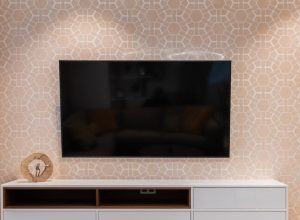So you’ve bought a curved or flat-screen TV and you want to buy an appropriate wall mount for it.
Of course, you will naturally think about the obvious requirements that the mount must fulfill. Examples of these would be if it’s appropriate for your TV’s size and weight or not.
However, did you know that the type of mount you get is also something you must take into account and decide?
Quick summary
In this post, we will discuss in detail the different types of mounts that are available in the market, how they work, and which one you should get based on your needs.
The types of mounts we will discuss in this post include:
- Fixed TV mounts
- Tilting TV mounts
- TV mount stands
- Ceiling TV mounts
- Swivel TV mounts
- Full-motion TV mounts
We highly recommend that you read about all the different types of TV mounts that are available to you in the market. That way, you will be able to identify a type of mount that fulfills all of your needs perfectly.
So without further ado, let’s get started.
Different Types of TV Mounts Explained
The types of mounts are typically separated in terms of the level of motion they provide and how they provide it.
Thus, in most cases, you will base your decision regarding which type of mount will be best for you by thinking about how much motion you need from it.
For the purposes of this post, we have tried to have a sequence where we go from the types of mounts that offer the least amount of motion and slowly work our way up.
Let’s get into it:
Fixed TV Mount

Fixed TV mounts are by far the most classic and easy-to-understand wall mounts out there. They are also the most common ones that you’ll find in many American households.
As the name suggests, a fixed TV mount does not offer any range of motion at all. You can’t move the TV from its position at all once it’s fixed onto the TV mount.
While this may seem highly limiting and rigid, it’s often all you really need.
Just think about: in most cases, you will just watch TV while sitting on your couch, right? That’s only a single primary viewing angle that you have to take care of. It’s something that a fixed TV mount can easily take care of.
You just have to make sure that you install the mount properly at the correct location so that it serves that primary viewing angle.
Also, since they offer no range of motion at all, they are often the cheapest type of mount you can buy.

Tilting wall mounts are just one step ahead of fixed wall mounts.
They offer just one range of motion which is, you guessed it, tilting. They are shaped just like fixed mounts but they allow you to adjust the tilt angle of your TV up to certain degrees.
For most tilting TV mounts, you can tilt the TV backward 5 degrees and forwards 15 degrees. However, these measurements can vary depending on the model of the mount.
Tilting TV mounts are great if you intend to have your TV near a window or any other similar light source.
These light sources can cause glare on your TV screen which you can easily fix by adjusting the tilt angle.

A TV mount stand is kind of a hybrid between a mount and a stand.
It’s just a stand that has components on top of it that can be used to attach your TV. It’s definitely an option you can go for if you don’t want to drill holes in your wall.
Some TV stands offer a fair range of movements such as horizontal, tilt, and swivel. The price of TV mount stands often depends on how much motion they can provide to you.
They are definitely not a good option if you want to save space though.

This is where we start to get into the fun stuff.
Ceiling mounts add a very unique aesthetic to your living room or whatever space where you want to mount your TV. As the name suggests, these types of mount attach to your ceiling rather than any of the walls on the side.
This can open up a ton of space on your walls for pictures, posters, windows, and other objects you want to hang.
Many ceiling TV mounts are fixed whereas others can be rotated.
If you spend a bit more money, you can definitely get a ceiling mount that can rotate your TV a full 360-degrees.
Thus, ceiling mounts can be great if you have a space that has many different viewing angles. That way, no matter where you want to sit, you can always rotate the TV and find the correct angle for a pleasurable viewing experience.
Swivel TV Wall Mounts

Swivel TV wall mounts attach to your wall and are one of the types of TV mounts that provide a wide range of motion
They are definitely an option you should go for if you want a mount for a large space that has many different viewing angles.
It can be great for spaces such as offices, restaurants, lounges, etc.
If you have a mount that only has the swivel option, then it will allow you to turn your TV from side to side. The degree to which you can turn the TV will depend on the model of the swivel TV wall mount.
The angle can be as low as 30 degrees or as high as 180 degrees.
If you have a swivel mount that also has tilting capabilities, you will be able to not only move it side-to-side but also adjust its tilt.
This gives you a lot more flexibility with the positioning of your TV and it’s definitely something you should think about if you intend to get a swivel mount:
Should you get a regular swivel mount or a swivel/tilt mount?
Even though swivel mounts provide you with a very wide range of motion, they are still not the mount type that provides you with the widest range of motion…
Full-Motion Mounts

Full-motion wall mounts are becoming more and more popular as the days go by.
They are known to be extremely sturdy and the best ones are super easy to use even though they seem quite intimidating at first.
Full-motion mounts provide the widest range of motion out of all the mount types currently available in the market.
Hence, this is the option you should go for if you have a large space with tons of different viewing angles.
With a full-motion mount, you can:
- Swivel your TV from side-to-side
- Adjust its tilt angle
- Adjust its height
- Pull it out from the wall up to a certain length
- Retract it back into the wall when you want to save space
Thus, full-motion mounts are extremely versatile and provide you with options for different types of gatherings based on your needs.
Full-motion mounts take up a fair amount of space. Hence, it’s an option you should avoid if you have a cramped, small room. Remember that such a TV mount is meant for larger spaces.
Of course, just like all the other mount types above, the degree to which you can move the mount will depend on the model of the mount itself.
For example, many full-motion mounts allow you to extend the TV up to 30 inches from the wall. Whereas other cheaper options for full-motion mounts might only let you extend the TV up to 15 inches from the wall.
Hence, when you browse full-motion mounts, make sure that you check out the extent to which each movement can go. That’s the only way to make sure that all your needs will be fulfilled.
Unsurprisingly, since full-motion mounts are the most versatile of the bunch, they also tend to be the most expensive types of mounts.
Important note: You may find it intimidating to assemble a full-motion mount. If that is the case, it can be a good idea to buy a full-motion mount that comes fully assembled.
There are many of them available in the market.
Wrapping Things Up…
Adam F.
A/V and Home Theater Expert that focuses on providing clear as well as concise reviews for anything and everything Audio Visual. From TV's, TV Mounts, Soundbars, and Wiring, my focus is to provide expertise in everything Audio Visual focused.










